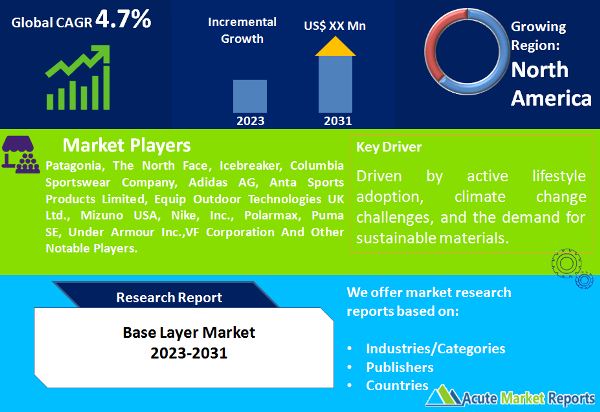
The base layer market plays a crucial role in providing comfort, insulation, and moisture management for various outdoor and active pursuits. The base layer market is expected to grow at a CAGR of 4.7% during the forecast period of 2025 to 2033, driven by active lifestyle adoption, climate change challenges, and the demand for sustainable materials. While supply chain disruptions pose a significant restraint, the market is expected to expand, especially in regions where outdoor activities and athleisure fashion are on the rise. The competitive landscape is marked by key players committed to delivering versatile and sustainable base layers that cater to the evolving needs of consumers.

Active Lifestyle Adoption
Rising Health Consciousness: One of the primary drivers fueling the base layer market is the increasing adoption of an active lifestyle driven by rising health consciousness. In 2024, there was a significant surge in people prioritizing fitness and outdoor activities. This shift in lifestyle has bolstered the demand for base layers designed to provide comfort, moisture-wicking properties, and thermal regulation. This trend is expected to continue into the forecast period from 2025 to 2033 as more individuals incorporate outdoor and sports activities into their routines.
Athleisure Fashion Trend: The athleisure fashion trend is another significant driver. In 2024, the fusion of fashion and function became increasingly prevalent, with consumers seeking versatile and stylish base layers that can be worn not only during workouts but also in daily life. Base layers that combine performance with fashion aesthetics saw substantial growth. This trend is anticipated to persist during the forecast period as athleisure remains a prominent and evolving segment of the apparel industry.
Climate Change and Extreme Conditions
Extreme Weather Events: The second key driver is the impact of climate change and the increasing occurrence of extreme weather events. In 2024, regions around the world experienced extreme cold, heat, and precipitation. This has led to a growing need for high-performance base layers that can adapt to changing weather conditions. Base layers designed to offer thermal insulation, moisture management, and breathability have become essential for outdoor enthusiasts and professionals. This trend is expected to continue into the forecast period as unpredictable weather patterns persist.
Sustainable and Eco-Friendly Materials
Environmentally Conscious Choices: The third driver is the growing emphasis on sustainable and eco-friendly materials. In 2024, consumers displayed a preference for base layers made from materials that have a reduced environmental impact. Fabrics like merino wool, which is biodegradable and renewable, gained popularity. This trend is anticipated to persist during the forecast period as eco-conscious consumers seek base layers that align with their values and environmental responsibility.
Supply Chain Disruptions
Global Challenges: A significant restraint impacting the base layer market is supply chain disruptions, which were experienced in 2024 due to various global challenges. These disruptions included transportation bottlenecks, import/export restrictions, and labor shortages, all of which affected the production and distribution of base layers. This restraint is expected to persist during the forecast period, especially if global issues such as climate change and political instability continue to impact the industry.
Product (Tops, Bottoms): Tops Dominate the Market
In 2024, tops, including base layer shirts, recorded the highest revenue due to their versatile use in various outdoor activities and the athleisure trend. However, during the forecast period from 2025 to 2033, bottoms are expected to exhibit the highest compound annual growth rate (CAGR). Base layer bottoms, such as leggings and tights, are becoming increasingly popular for their role in providing warmth, support, and flexibility during physical activities. While tops are expected to maintain their revenue leadership, bottoms are poised for significant growth.
Material (Polyester, Merino Wool, Nylon, Cotton, Others): Polyester base layers Dominate the Market
In 2024, polyester base layers generated the highest revenue due to their affordability and moisture-wicking properties. However, during the forecast period from 2025 to 2033, merino wool is expected to exhibit the highest CAGR. Merino wool base layers are known for their natural insulation, moisture management, and odor resistance. While polyester is expected to maintain its revenue leadership, merino wool is set for substantial growth, driven by consumer preferences for sustainable and high-performance materials.
North America Remains the Global Leader
In 2024, North America led in terms of both the highest revenue and the highest CAGR in the base layer market. North America's diverse climate, active lifestyle culture, and athleisure trends contributed to its strong performance. The region is expected to maintain its revenue leadership during the forecast period. Additionally, Europe, with its growing outdoor recreation and sustainable fashion movements, is another region with significant revenue percentages in 2024 and is expected to maintain this position during the forecast period.
Strategic Partnerships to Decide on Market Share of Competitors
In the competitive landscape of the base layer market, key players such as Patagonia, The North Face, Icebreaker, Columbia Sportswear Company, Adidas AG, Anta Sports Products Limited, Equip Outdoor Technologies UK Ltd., Mizuno USA, Nike, Inc., Polarmax, Puma SE, Under Armour Inc., and VF Corporation have been at the forefront of innovation and product development. These companies have consistently invested in research and development to enhance their base layer offerings and have formed strategic partnerships with retailers and e-commerce platforms to reach a wider audience. In 2024, these industry leaders secured substantial revenue shares, and they are expected to maintain their positions during the forecast period from 2025 to 2033. Their strategies encompass producing high-quality base layers that cater to diverse consumer needs, embracing sustainable material choices, and adapting to changing weather conditions. Moreover, they are actively involved in addressing supply chain disruptions by streamlining their production and distribution processes.
Historical & Forecast Period
This study report represents analysis of each segment from 2023 to 2033 considering 2024 as the base year. Compounded Annual Growth Rate (CAGR) for each of the respective segments estimated for the forecast period of 2025 to 2033.
The current report comprises of quantitative market estimations for each micro market for every geographical region and qualitative market analysis such as micro and macro environment analysis, market trends, competitive intelligence, segment analysis, porters five force model, top winning strategies, top investment markets, emerging trends and technological analysis, case studies, strategic conclusions and recommendations and other key market insights.
Research Methodology
The complete research study was conducted in three phases, namely: secondary research, primary research, and expert panel review. key data point that enables the estimation of Base Layer market are as follows:
Market forecast was performed through proprietary software that analyzes various qualitative and quantitative factors. Growth rate and CAGR were estimated through intensive secondary and primary research. Data triangulation across various data points provides accuracy across various analyzed market segments in the report. Application of both top down and bottom-up approach for validation of market estimation assures logical, methodical and mathematical consistency of the quantitative data.
| ATTRIBUTE | DETAILS |
|---|---|
| Research Period | 2023-2033 |
| Base Year | 2024 |
| Forecast Period | 2025-2033 |
| Historical Year | 2023 |
| Unit | USD Million |
| Segmentation | |
Product
| |
Material
| |
Weight
| |
Price
| |
Application
| |
End-User
| |
Distribution Channel
| |
|
Region Segment (2023-2033; US$ Million)
|
Key questions answered in this report